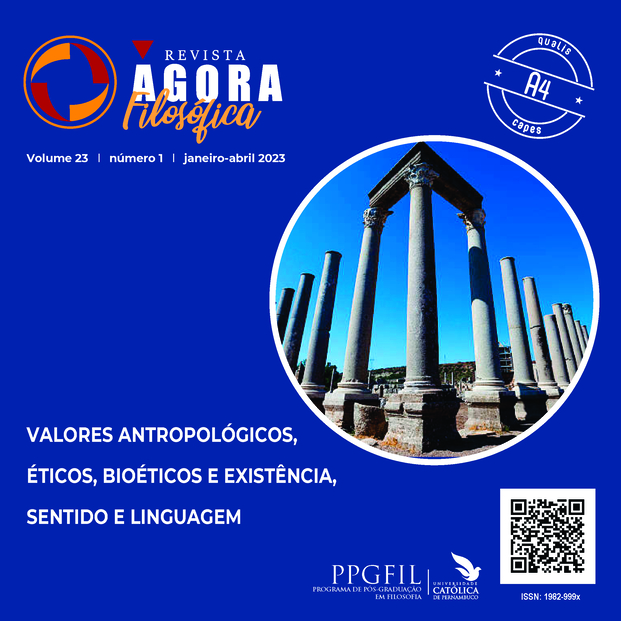If Walls Could Talk: Politics, Sound, Otherness
DOI:
https://doi.org/10.25247/P1982-999X.2023.v23n1.p09-26Palabras clave:
Barriers, Musicology, Political-critical philosophy, Discrimination, Identity, ContemporaryResumen
Este artículo relaciona el tema filosófico del muro y las barreras con la musicalidad. En varias épocas, la música ha tenido un significado político progresista, mientras que el mundo contemporáneo expresa su carácter regresivo en formas musicales comerciales y marketing sonoro. Las formas cerradas y obsesivas del universo tecnológico parecen universos de libertad expresiva mientras que, por el contrario, el lenguaje de las formas armónicas se ha empobrecido y se caracteriza muchas veces por ritmos repetitivos con fuertes repercusiones identitarias. Por ello, el presente ensayo analiza el tema del muro refiriéndose a la música como una forma expresiva y artística nacida para la comunidad y en sí misma abierta. Sin embargo, a menudo hoy en día, la música se utiliza para estrategias de marketing o como vehículo para el suprematismo racial, la discriminación y la xenofobia. Partiendo del análisis de modismos comunes como “si las paredes hablaran” o “las paredes también tuvieran oídos”, este artículo se centra en la diferencia entre la música utilizada como democracia/espacio abierto y como instrumento para una fuerte y cerrada regresión identitaria.
Descargas
Referencias
AA.VV., Government and Opposition, Volume 38, Issue 1, Cambridge: Cambridge University Press, 2003, pp. 113 - 130.
AA.VV., Music and Conflict edited by John Morgano O’Connell and Salwa El Shawan Castelo Branco, Champaign: University of Illinois, 2010.
ADORNO T.W., Philosophy of New Music, Minnesota: Minnesota University Press, 2006.
BLACKING J., The Musical Sense, trans. Eric and Marika Blondel (Paris: Éditions de Minuit, 1980), See How Musical Is Man?, Seattle: University of Washington Press. 1973. -
BENJAMIN W., The Work of Art in the Age of Mechanical Reproduction, London: Penguin, 2008.
COLLI G., Filosofia dell’espressione, Milano: Adelphi, 1969.
DELEUZE G.; GUATTARI F., A Thousand Planes, Minnesota: University of Minnesota Press, 1987.
DONEGANI J.M., Music and Politics: The Language of Music – between Objective Expression and Subjective Reality in Raisons politiques, Volume 14, Issue 2, 2004.
ECO U., The Open Work, Harvard: Harvard University Press, 1989.
GARRATT J., Music and Politics. A Critical Introduction, Cambridge: Cambridge University Press, 2019.
HENWOOD B., The History of American protest music in https://www.vox.com/culture/2017/4/12/14462948/protest-music-history-america-trump-beyonce-dylan-misty
MASSAKA I., Music in the field of Political Sciences. Research, Questions and Trends in Polish Political Sciences, Vol. XLII, 2013.
NIETZSCHE F., Untimely Mediations, Cambridge: Cambridge University Press, 1997.
STREET J., Music and Politics, Cambridge and Malden: Polity Press, 2012.
THOMSON R., The Intertwined Relationship Between Music And Politics in https://liveforlivemusic.com/features/the-intertwined-relationship-between-music-and-politics/, February 2016.
WALTERS D., The aesthetics of Pierre Boulez, Durham University, http://etheses.dur.ac.uk/3093.
Descargas
Publicado
Número
Sección
Licencia
Derechos de autor 2023 Alberto Simonetti

Esta obra está bajo una licencia internacional Creative Commons Atribución 4.0.
Usted es libre de:
- Compartir — copiar y redistribuir el material en cualquier medio o formato para cualquier propósito, incluso comercialmente.
- Adaptar — remezclar, transformar y construir a partir del material para cualquier propósito, incluso comercialmente.
- La licenciante no puede revocar estas libertades en tanto usted siga los términos de la licencia
Bajo los siguientes términos:
- Atribución — Usted debe dar crédito de manera adecuada , brindar un enlace a la licencia, e indicar si se han realizado cambios . Puede hacerlo en cualquier forma razonable, pero no de forma tal que sugiera que usted o su uso tienen el apoyo de la licenciante.
- No hay restricciones adicionales — No puede aplicar términos legales ni medidas tecnológicas que restrinjan legalmente a otras a hacer cualquier uso permitido por la licencia.
Avisos:
No tiene que cumplir con la licencia para elementos del materiale en el dominio público o cuando su uso esté permitido por una excepción o limitación aplicable.
No se dan garantías. La licencia podría no darle todos los permisos que necesita para el uso que tenga previsto. Por ejemplo, otros derechos como publicidad, privacidad, o derechos morales pueden limitar la forma en que utilice el material.
















